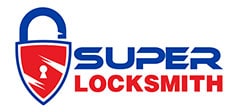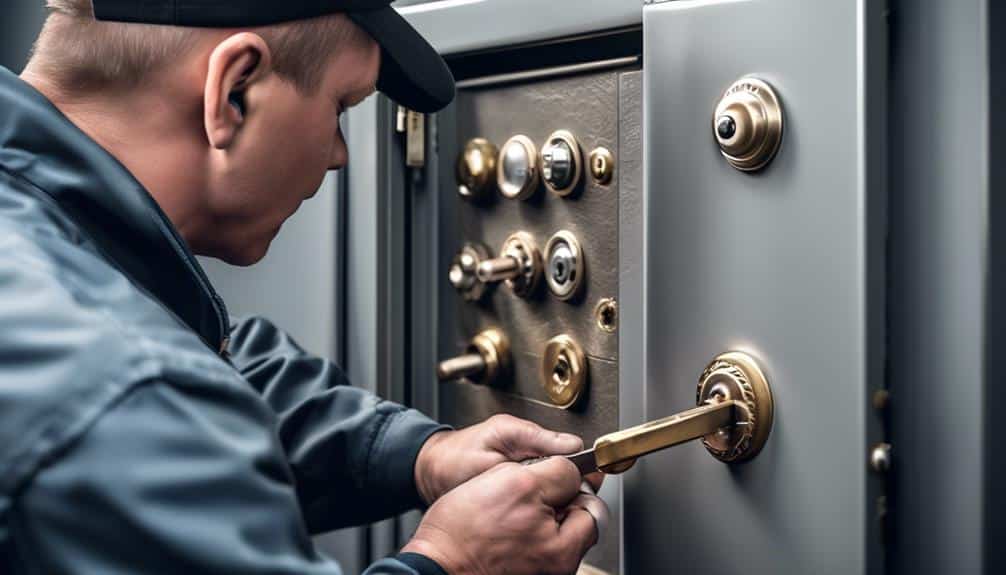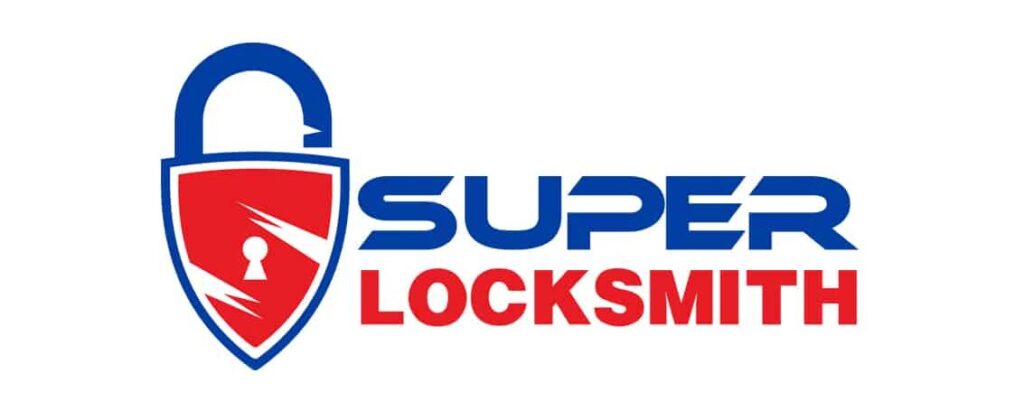Did you know that according to recent studies, approximately 2.5 million burglaries occur in the United States each year? It's a staggering number that highlights the importance of securing our valuables.
If you're looking to protect your belongings with a safe or vault, mastering lock installation is crucial. In this discussion, we will explore seven essential tips that will help you enhance the security of your safes and vaults.
From choosing the right locking mechanism to troubleshooting common lock issues, we'll provide you with the knowledge and expertise you need to ensure the utmost protection for your valuables.
So, let's dive right in and discover how to fortify your security measures effectively.
Types of Safes and Vaults
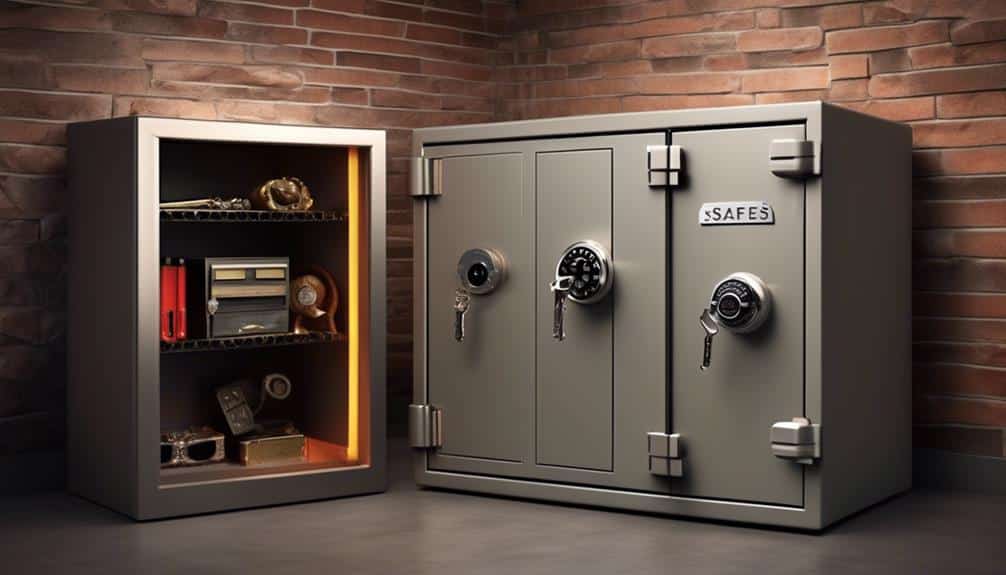
There are various types of safes and vaults available, each designed to cater to specific security needs and requirements. When it comes to protecting valuable items and documents, fireproof safes are a popular choice. These safes are specifically designed to withstand high temperatures and protect contents from fire damage. They're constructed using fire-resistant materials such as steel and are equipped with fire seals to prevent smoke and water from entering the safe during a fire incident.
Another advanced type of safe is the biometric vault. These high-tech safes utilize biometric technology to provide secure access control. Biometric vaults typically feature fingerprint scanners or iris recognition systems that allow only authorized individuals to open the safe. This advanced level of security ensures that only approved personnel can access the contents, adding an extra layer of protection against unauthorized entry.
In addition to fireproof safes and biometric vaults, there are also other types of safes and vaults available, such as wall safes, floor safes, and jewelry safes. Wall safes are mounted into the wall, offering discreet storage for valuables. Floor safes are installed into the floor, providing hidden protection. Jewelry safes are specifically designed to store and protect valuable jewelry items.
Choosing the Right Locking Mechanism
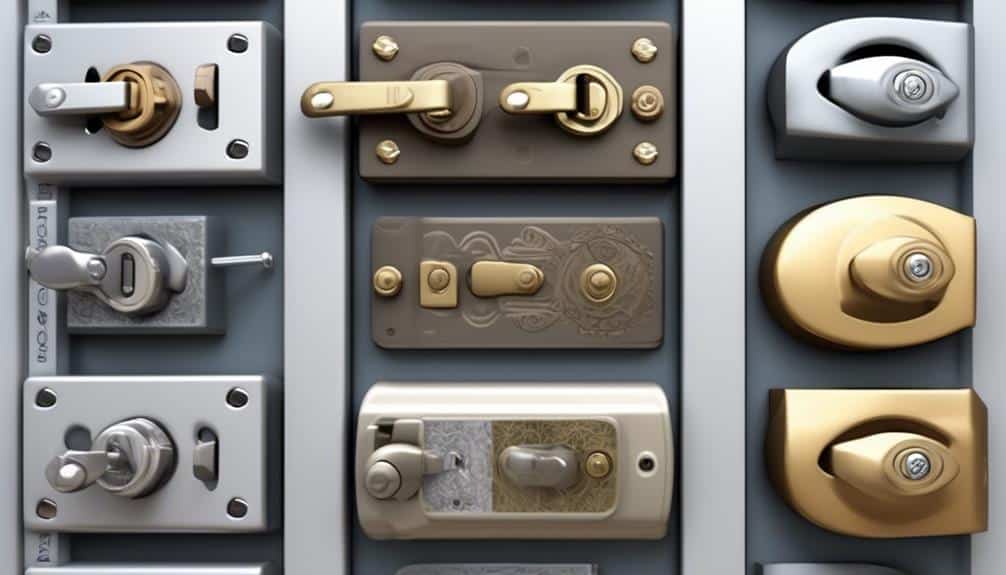
When choosing the right locking mechanism for your safe or vault, it's important to consider the different types of lock mechanisms available, the factors that are unique to your specific security needs, and the best practices for installation.
Understanding the various lock mechanism types, such as electronic, mechanical, or biometric, will allow you to make an informed decision based on your requirements.
Additionally, factors such as level of security, ease of use, and maintenance should be carefully considered to ensure that the chosen locking mechanism meets your needs effectively.
Lock Mechanism Types
To choose the right locking mechanism for your safe or vault, it's important to consider various factors such as security level, ease of use, and durability. Lock mechanism types have evolved over time, offering a range of options to suit different needs. Here are three common types to consider:
- Keyless Entry:
- Keyless entry systems provide convenience and enhanced security.
- These mechanisms use electronic keypads or touchscreens to allow access to the safe or vault.
- Users can set personalized codes or passwords for added security.
- Some systems also offer features like time delay or audit trails.
- Biometric Locks:
- Biometric locks utilize unique physical characteristics, such as fingerprints or iris scans, to grant access.
- These locks offer a high level of security as biometric data is difficult to replicate.
- They're also user-friendly, eliminating the need for keys or codes.
- Combination Locks:
- Combination locks have been a popular choice for safes and vaults for many years.
- They require a specific sequence of numbers or symbols to unlock.
- Combination locks are reliable and durable, making them suitable for high-security applications.
When selecting a locking mechanism, assess your security requirements and consider factors like ease of use and durability.
Factors to Consider
One important factor to consider when choosing the right locking mechanism for your safe or vault is the level of security it provides. The type of lock you select will determine how well your valuables are protected. There are several factors to consider when buying a safe or choosing a reliable vault for your needs. These include the type of lock, the material of the safe, the size and weight, and the fire resistance rating. To help you make an informed decision, we have created a table with three columns and five rows that outlines these factors:
| Factors to Consider | Description | Importance |
|---|---|---|
| Type of Lock | Different types include electronic keypad, combination dial, and biometric | High |
| Material of Safe | Options include steel, composite, and fireproof materials | Medium |
| Size and Weight | Consider the dimensions and weight capacity of the safe or vault | Medium |
| Fire Resistance Rating | Look for safes with a high fire resistance rating to protect important documents | High |
| Additional Security Features | Consider features like secondary key locks or alarm systems | Low |
Installation Best Practices
After considering the factors involved in choosing the right locking mechanism for your safe or vault, it's crucial to follow installation best practices to ensure optimal security. Proper installation techniques can significantly enhance the effectiveness of your lock, preventing common mistakes that could compromise the safety of your valuables.
Here are three essential installation practices to keep in mind:
- Alignment: Ensure the lock is precisely aligned with the boltwork, allowing for smooth and accurate operation. Misalignment can lead to difficulties in opening and closing the safe or vault.
- Secure Fastening: Use high-quality, tamper-resistant fasteners to securely attach the lock to the safe or vault. Loose or weak fasteners can make it easier for unauthorized individuals to tamper with the lock.
- Adequate Clearance: Ensure that there's enough clearance around the lock to allow for proper operation. Lack of clearance can cause binding or interference, leading to lock malfunctions.
Proper Placement and Installation
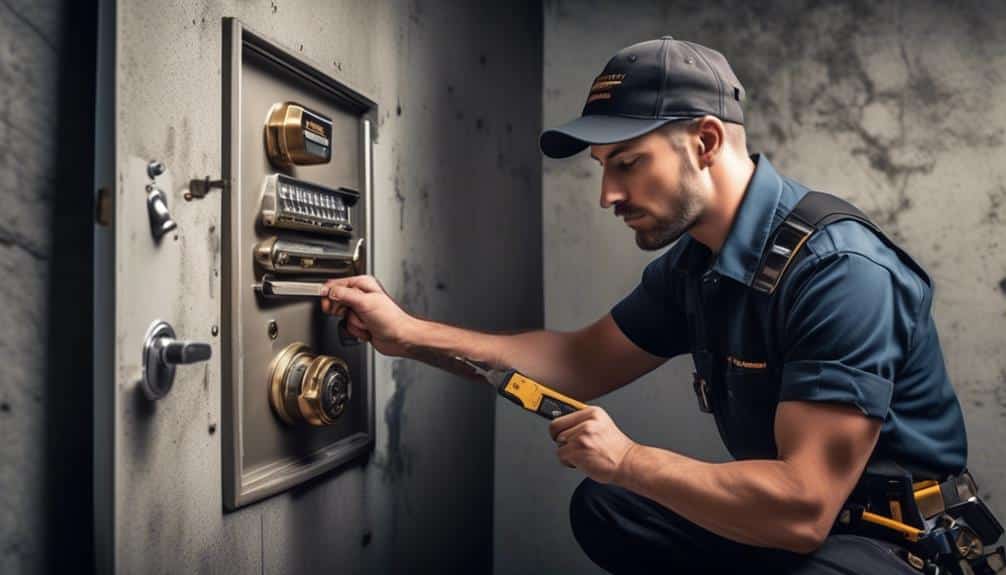
Proper placement and installation of a safe or vault is crucial to ensure maximum security and functionality. By following these installation tips, you can optimize the placement of your safe or vault and enhance its overall effectiveness.
One important consideration when installing a safe or vault is its location. It should be placed in an area that is easily accessible to authorized individuals but not easily visible or accessible to potential intruders. Additionally, the floor on which the safe or vault is installed should be sturdy enough to support its weight and should not have any weak spots that could be exploited.
Another installation tip is to ensure that the safe or vault is securely anchored to the floor or wall. This prevents unauthorized individuals from moving or removing the safe or vault, increasing its resistance to theft or tampering. Anchoring can be achieved using bolts or other suitable fasteners.
Lastly, proper installation of the locking mechanism is essential. The table below outlines the basic steps for installing a typical combination lock:
| Step | Description |
|---|---|
| 1 | Mark the desired location for the lock on the door of the safe or vault. |
| 2 | Drill holes for the lock's mounting screws. |
| 3 | Attach the lock to the door using the mounting screws. |
| 4 | Test the lock to ensure it operates smoothly and securely. |
| 5 | Secure any exposed wiring or components to prevent tampering. |
Securing the Door and Frame
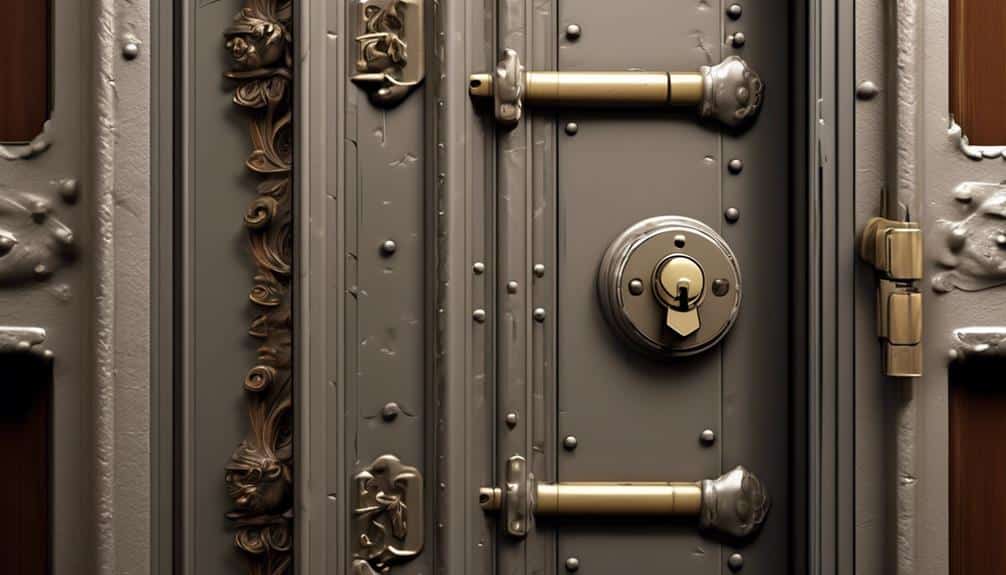
To ensure the utmost security and functionality of your safe or vault, the door and frame must be meticulously secured. Proper door reinforcement and the use of appropriate security hardware are essential to prevent unauthorized access and protect valuable assets. Here are three key considerations when securing the door and frame:
- Door Material: The material of the door plays a crucial role in its resistance against physical attacks. Opt for solid steel doors that are thick and sturdy, as they provide enhanced protection against drilling, cutting, and prying attempts.
- Frame Strength: Reinforcing the door frame is equally important to ensure the overall security of the safe or vault. Install a heavy-duty steel frame that's securely anchored to the surrounding structure. This will help resist forced entry attempts and reinforce the structural integrity of the door.
- Security Hardware: Utilize high-quality security hardware to further enhance the safety of the door and frame. This includes robust hinges, deadbolts, and multi-point locking systems. Ensure that all hardware components are resistant to tampering and have been tested against industry standards.
Enhancing Security With Additional Features
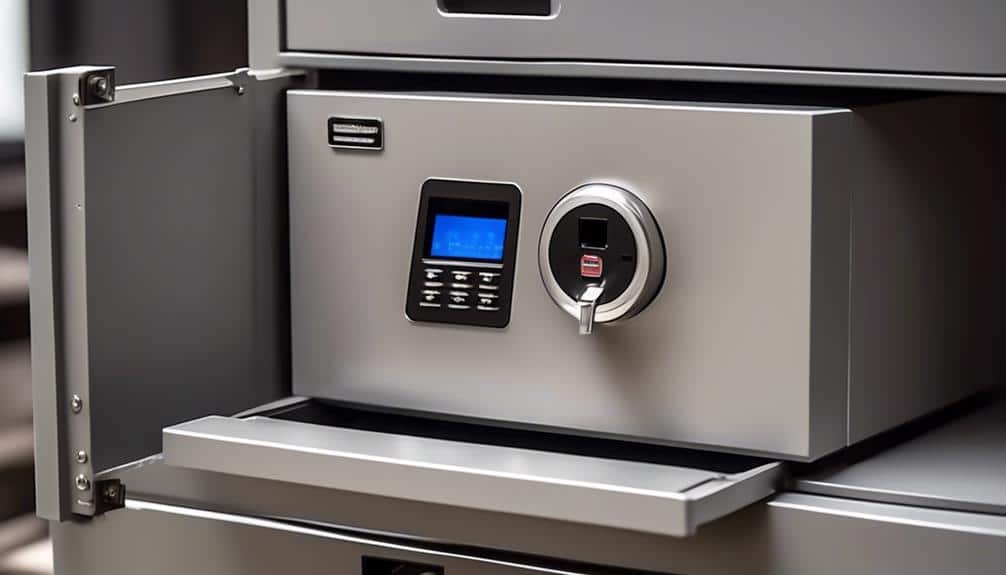
For enhanced security, consider incorporating additional features into your safe or vault. One option to consider is smart lock technology. Smart locks offer advanced security features such as biometric authentication, remote access control, and activity monitoring. With biometric authentication, only authorized individuals can access the safe or vault, as it requires a fingerprint or retinal scan to unlock. Remote access control allows you to lock and unlock the safe or vault remotely, providing convenience and control from anywhere. Activity monitoring tracks and records all access attempts, providing a detailed log of who accessed the safe or vault and when.
Another additional feature to enhance security is an alarm system. An alarm system can detect and alert you to any unauthorized access attempts or tampering. It can be integrated with smart lock technology to provide a comprehensive security solution. When an unauthorized attempt is detected, the alarm can sound a loud siren, send notifications to your smartphone, or even alert a security company. This immediate response can deter intruders and give you peace of mind knowing that your safe or vault is well-protected.
Regular Maintenance and Inspection
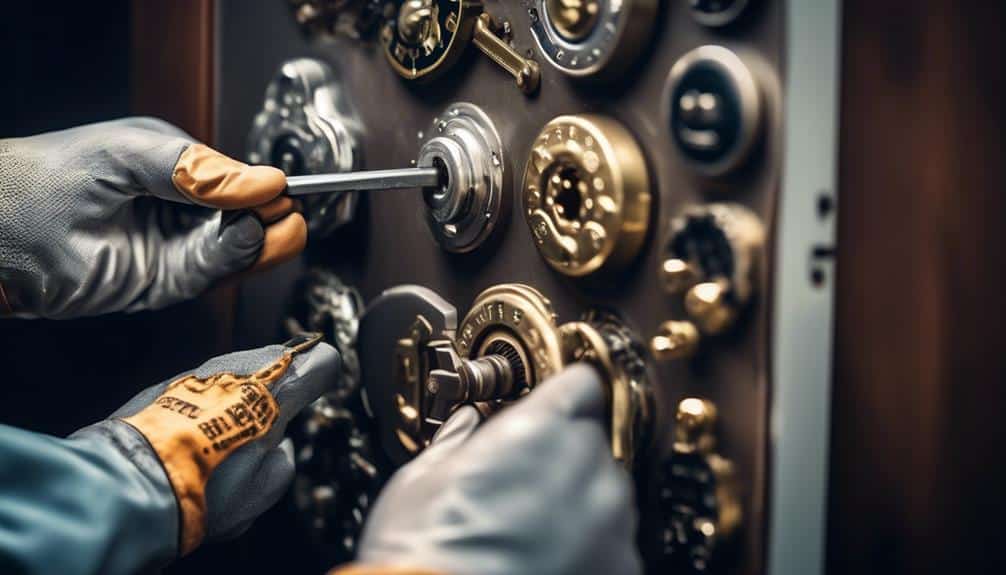
Regular maintenance and inspection are crucial for ensuring the optimal functioning and security of safes and vaults. By conducting routine check-ups and preventive maintenance, potential issues can be identified and addressed before they escalate into major problems.
This includes inspecting the locking mechanisms, hinges, and other components, as well as cleaning and lubricating them as needed to maintain smooth operation.
Routine Check-Ups
We conduct routine check-ups on safes and vaults to ensure their optimal functionality and security. Regular maintenance is essential for the longevity of these security systems.
Here are three important aspects of routine check-ups for safes and vaults:
- Lubrication: We apply lubricants to the moving parts of the lock mechanism to ensure smooth operation. This prevents friction and wear that could compromise the lock's effectiveness.
- Inspection of hinges and bolts: We carefully examine the hinges and bolts to identify any signs of damage or wear. If necessary, we replace them to maintain the structural integrity of the safe or vault.
- Electronic system calibration: For electronic safes or vaults, we calibrate the electronic systems to ensure accurate operation. This includes testing the keypad, biometric scanner, or any other electronic components for functionality and responsiveness.
Preventive Maintenance
To ensure the optimal functionality and longevity of safes and vaults, regular maintenance and inspection are crucial. Implementing preventive measures is essential to prevent potential issues and keep your safes and vaults in top condition. A comprehensive maintenance checklist can help with this.
Start by inspecting the locking mechanism, checking for any signs of wear or damage. Lubricate all moving parts to ensure smooth operation. Examine the door hinges and bolts for any misalignment or looseness. Inspect the sealant around the door to ensure it's intact and provides proper protection against external elements.
Test the electronic components, such as the keypad or biometric scanner, to guarantee they're functioning correctly. Regularly clean the interior to remove any debris or dust that can affect the performance of the safe or vault.
Troubleshooting Common Lock Issues
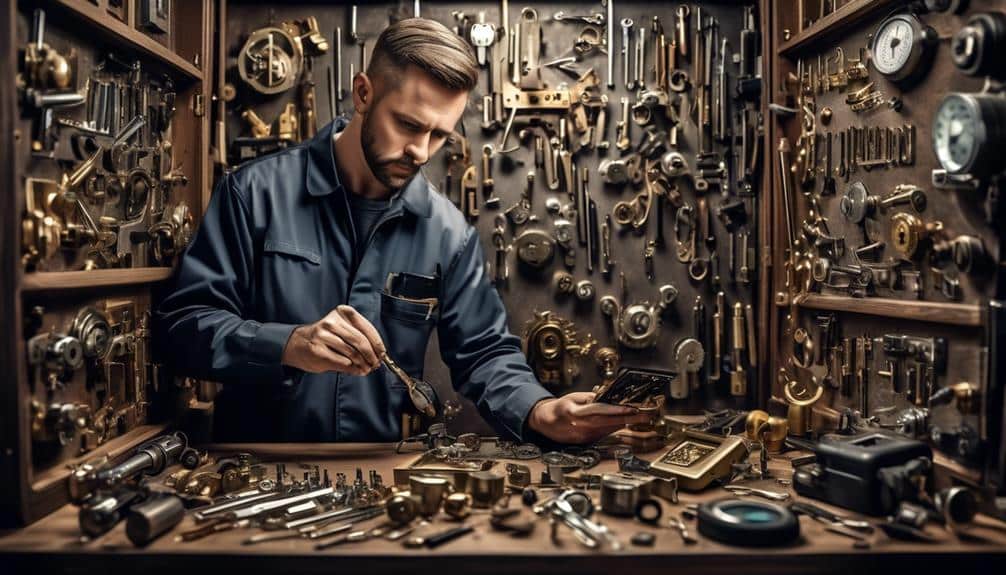
When encountering common lock issues, it's crucial to approach troubleshooting with technical expertise and precision. As locksmiths, we understand the importance of quickly identifying and resolving these problems to ensure the security of our clients' safes and vaults. Here are three common lock problems that we frequently encounter and how to troubleshoot them effectively:
- Sticking or Jammed Lock: If a lock becomes sticky or jammed, it can be due to a buildup of dirt, debris, or rust within the lock mechanism. Start by applying a lubricant specifically designed for locks to the keyway and try operating the lock again. If the issue persists, disassembling the lock and cleaning each component thoroughly may be necessary.
- Key Won't Turn: When a key won't turn in the lock, it could be due to a bent or worn key, or a misaligned lock mechanism. Inspect the key for any visible damage and consider trying a spare key. If the problem persists, a locksmith can help realign or replace the lock mechanism to ensure smooth operation.
- Deadbolt Doesn't Fully Extend: If a deadbolt doesn't fully extend when the lock is engaged, it could indicate a problem with the strike plate or misalignment between the lock and strike plate. Check for any loose screws on the strike plate and tighten them if necessary. If the problem persists, adjusting the strike plate or the lock's position may be required.
Frequently Asked Questions
Can I Install a Safe or Vault on My Own, or Do I Need to Hire a Professional?
Installing a safe or vault on our own might seem like a Herculean task, but fear not! While it's technically possible to install one ourselves, the benefits of hiring a professional can't be overstated.
They possess the precise knowledge and expertise needed to ensure a flawless installation. From assessing the best location to securely anchoring the safe, their technical prowess guarantees maximum protection for your valuables.
How Often Should I Change the Combination or Password for My Safe or Vault Lock?
Changing the combination or password for your safe or vault lock is an important security measure. The frequency of changing it depends on various factors, such as the level of security needed and the sensitivity of the contents.
It's recommended to change the combination or password periodically to maintain a high level of security. Additionally, it's crucial to choose a strong password that includes a combination of letters, numbers, and special characters to prevent unauthorized access.
What Are the Best Practices for Storing and Organizing Items Within a Safe or Vault?
When it comes to storing and organizing items within a safe or vault, there are some essential best practices to follow.
Proper storage techniques for sensitive documents involve using acid-free folders or envelopes, labeling them clearly, and arranging them in a logical order.
For organizing valuable items, consider using dividers or storage containers to keep them separate and prevent scratching or damage.
It's also important to regularly inventory and update your stored items to ensure everything is accounted for.
Are There Any Specific Regulations or Guidelines Regarding the Installation of Safes and Vaults in Commercial Buildings?
Regulations and guidelines exist for safe installation in commercial buildings. Safe installation requirements and commercial building safe installation standards ensure the security and proper functioning of safes and vaults. These regulations and guidelines cover various aspects such as the type of locks to be used, the placement of safes and vaults, and the structural integrity of the installation.
Adhering to these standards is crucial to maintain the safety and protection of valuable assets in commercial settings.
What Steps Should I Take if I Forget the Combination or Password for My Safe or Vault Lock?
Forgetting the combination or password to your safe or vault lock can be a stressful situation. But fear not, there are steps we can take to recover the combination and prevent lockouts in the future.
First, try resetting the lock according to the manufacturer's instructions. If that doesn't work, contact a professional locksmith who's experience with safes and vaults. They can help you retrieve the combination or reset the lock.
Remember to keep a backup of your combination in a secure place to avoid future mishaps.
